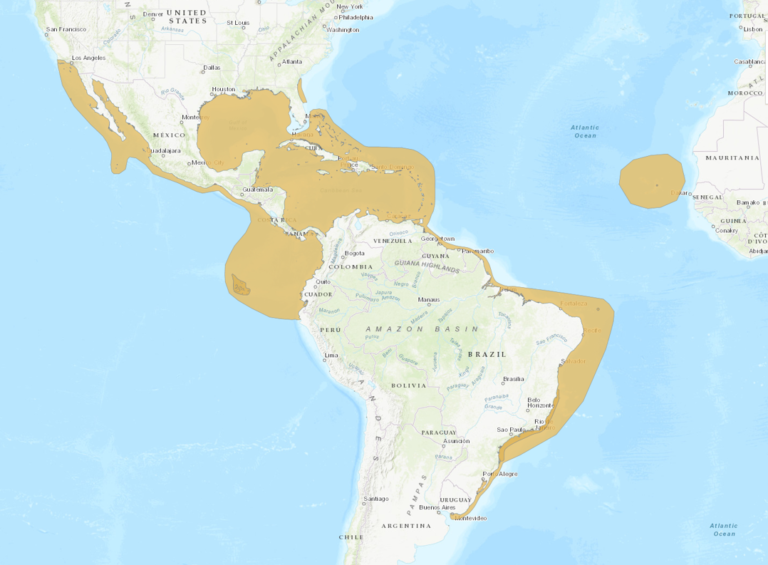Birdfinding.info ⇒ Very common, approaching ubiquitous, throughout most of the West Indies and along both coasts of Latin America from Mexico to northwestern Peru and southern Brazil. In much of its range it can be seen soaring over all coastal habitats, including port cities and beaches. In the U.S., it is common year-round in the Florida Keys (especially at Dry Tortugas National Park) and along the lower Gulf Coast of Florida, uncommon and unpredictable along the rest of the Gulf Coast to Texas; rare and irregular along the Atlantic north to Cape Lookout, North Carolina.
Magnificent Frigatebird
Fregata magnificens
Tropical and subtropical coasts and nearshore waters of the Americas and Cape Verde.
Breeding. In the Caribbean, there are approximately 80 colonies on islets from the Marquesas (Florida) and northern Bahamas south to the southern Gulf of Mexico, Belize, Corn Islands (Nicaragua), Venezuela, and Tobago. The largest colony in the region is approximately 2,000 pairs at Codrington Lagoon on Barbuda.
In the Pacific, there are colonies on near-coastal islets from Baja California Sur and Sinaloa south to Ecuador, and on the Revillagigedo (San Benedicto) and Galápagos Islands.
In the South Atlantic, breeds on Fernando de Noronha and several nearshore islets along the southeastern coast of Brazil from Espírito Santo to São Paulo.
In the eastern North Atlantic, breeds (or bred) in the Cape Verde Islands on Boavista—but this population has dwindled to a few individuals and seems likely to vanish in the 2020s (or so).
Nonbreeding. Wanders year-round throughout its breeding range, usually roosting communally away from breeding colonies.
During the warmer months, a few disperse outside the core range: north to California and North Carolina, east to Bermuda, and south to southern Peru and Uruguay.
Exceptionally wanders more distantly. It has been recorded on multiple occasions north to Alaska and Newfoundland, inland to Wisconsin, Michigan, and Ontario, south to central Chile and Argentina, and east to the Azores and northern Spain, once to the Inner Hebrides of Scotland.

Magnificent Frigatebird breeding sites in the Caribbean. © West Indian Breeding Seabird Atlas 2009
Identification
Spectacular. The largest and most readily observed frigatebird: its full length is about one meter and its wingspan approaches 2.5 meters.
Its plumages are simpler and less variable than some other frigatebird species, but are still complex and potentially confusing.
Acquires its definitive adult plumage over the course of several years, resulting in six more or less distinct plumages: juvenile, older immature, and the subadult and adult plumages of each sex.
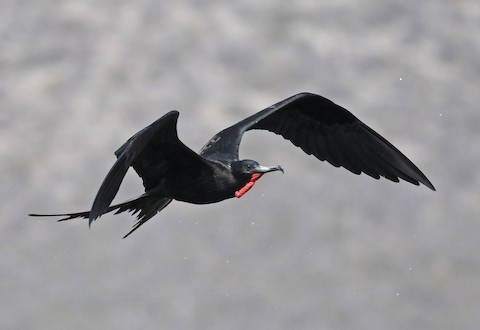
Magnificent Frigatebird, male appearing all-black. (Bahia de los Muertos, Baja California Sur, Mexico; March 14, 2010.) © Steven Mlodinow
Adult Male. Adult male has all-blackish plumage, and is therefore effectively identical to adult male Great and (dark morph) Ascension Frigatebirds.
In strong light, certain feather groups reflect some iridescence, usually purplish or coppery.
Like all male frigatebirds, it has a bright-red throat-pouch, which it inflates like a balloon during mating and dominance displays, but can be inconspicuous when deflated.
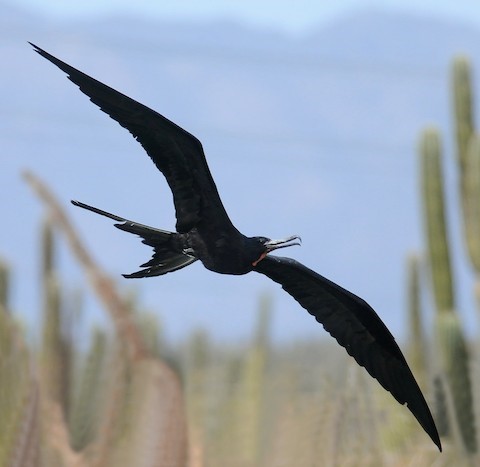
Magnificent Frigatebird, male appearing all-black. (Bahia de los Muertos, Baja California Sur, Mexico; March 14, 2010.) © Steven Mlodinow

Magnificent Frigatebird, male appearing all-black. (Cerro Tijeretas, Isla San Cristóbal, Galápagos, Ecuador; November 24, 2019.) © David M. Bell
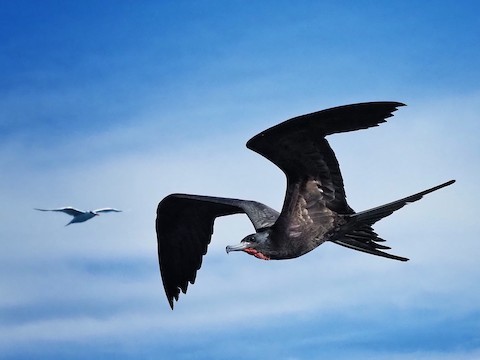
Magnificent Frigatebird, male, showing some purplish iridescence on the side. (Offshore from Melbourne, Florida; January 27, 2020.) © Chris Brown

Magnificent Frigatebird, male chasing a falling fish—note purplish gloss on back. (Brickfield, Trinidad; January 4, 2017.) © Tom Johnson

Magnificent Frigatebird, male showing purplish gloss on back. (Cahuita National Park, Costa Rica; February 23, 2016.) © James Dee
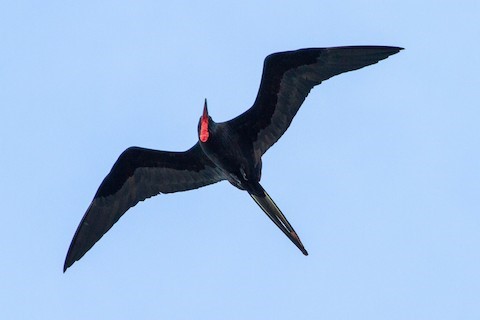
Magnificent Frigatebird, male appearing all-black except for deflated red throat-pouch. (Cancún, Quintana Roo, Mexico; December 14, 2018.) © Jean-François Garin
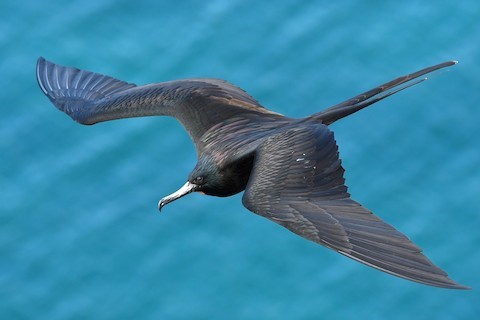
Magnificent Frigatebird, male, dorsal view show slight variations in tones of upperparts. (Cerro Tijeretas, Isla San Cristóbal, Galápagos, Ecuador; November 24, 2019.) © David M. Bell
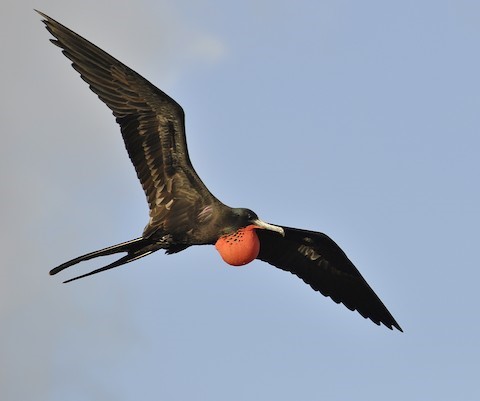
Magnificent Frigatebird, male displaying partially inflated throat-pouch in flight. (Lighthouse Reef, Half Moon Caye, Belize; December 19, 2016.) © Brendan Galvin
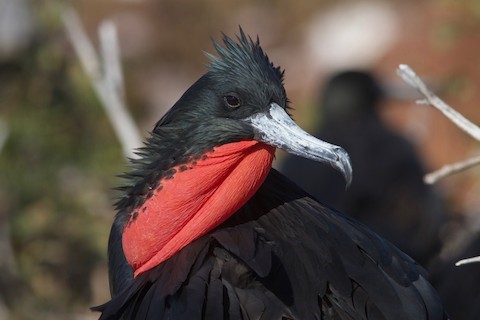
Magnificent Frigatebird, male with throat-pouch mostly deflated. (North Seymour Island, Galápagos, Ecuador; June 11, 2017.) © Ken Havard
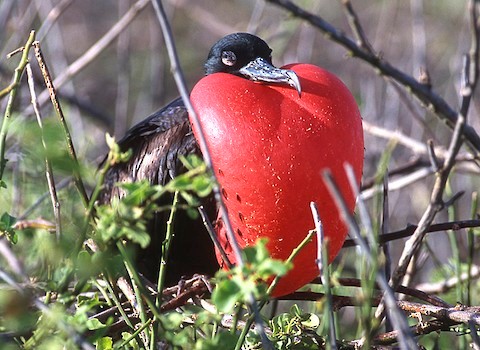
Magnificent Frigatebird, male displaying with fully inflated throat-pouch. (Isla Genovesa, Galápagos, Ecuador; May 22, 2005.) © Raniero Massoli Novelli
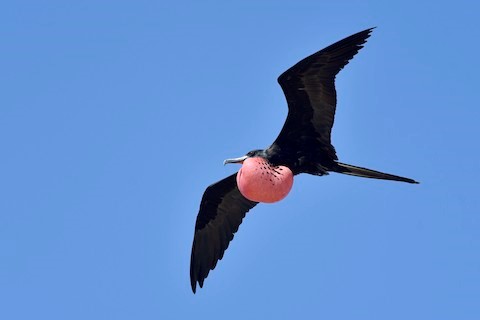
Magnificent Frigatebird, male displaying fully inflated throat-pouch in flight. (Dry Tortugas National Park, Florida; February 13, 2020.) © Daniel Irons
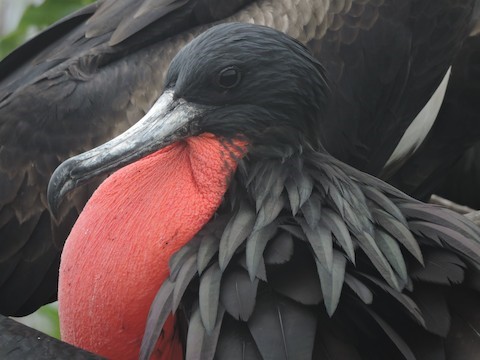
Magnificent Frigatebird, male with throat-pouch partially inflated. (Isla de la Plata, Ecuador; June 26, 2017.) © Michael Clay

Magnificent Frigatebird, male displaying with fully inflated throat-pouch. (North Seymour Island, Galápagos, Ecuador; May 22, 2014.) © Douglas Gimler
Adult Female. Adult female is mostly blackish with a large white vest and a distinct hood (unlike female Great).
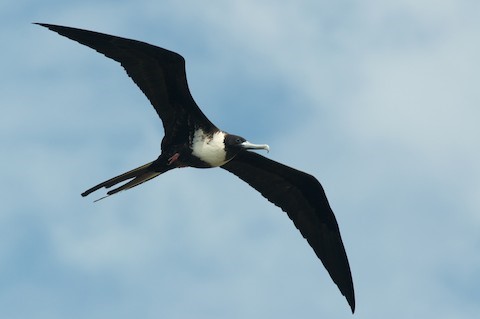
Magnificent Frigatebird, female, showing distinctive white vest and blackish hood. (Dry Tortugas National Park, Florida; April 20, 2016.) © Amanda Guercio
The shape of the white vest can be helpful in identification. First, it is “pinched” along the midline, as the blackish hood and belly both project toward one another. Second, narrow whitish projections extend into the “armpits.”

Magnificent Frigatebird, female, showing white markings projecting into the armpits. (Cancún, Quintana Roo, Mexico; February 17, 2015.) © Alexandre Gualhanone
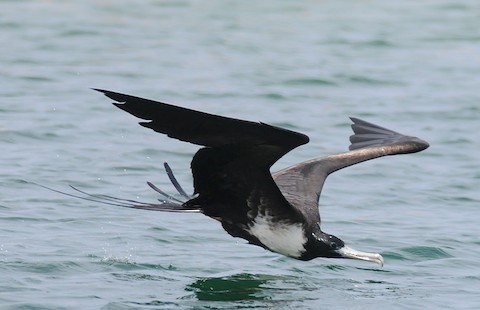
Magnificent Frigatebird, female, showing white markings projecting into the armpits—also note typical blond alar bar on upperwing and atypical whitish brow marking. (Bahia de los Muertos, Baja California Sur, Mexico; March 14, 2010.) © Steven Mlodinow

Magnificent Frigatebird, female, showing distinctive white vest and blackish hood. (East Beach, Galveston, Texas; September 7, 2016.) © Chirstian Fernandez
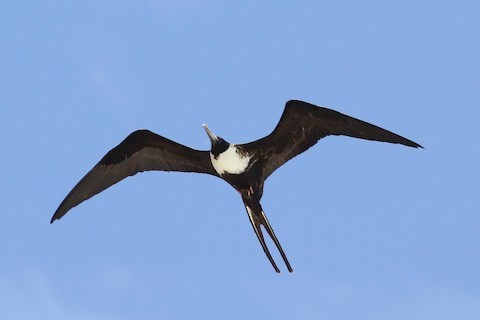
Magnificent Frigatebird, female, showing white vest with slight projections from the hood and the belly. (Isla San Juan, Baja California Sur, Mexico; April 16, 2019.) © Chris Wiley
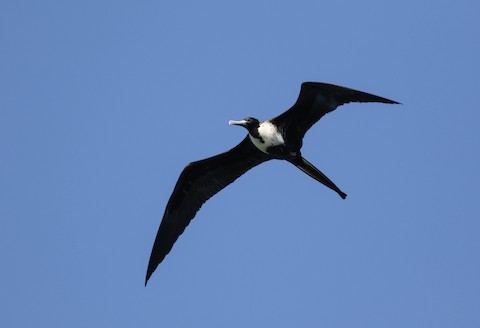
Magnificent Frigatebird, female, showing white vest with pronounced projections from the hood and the belly. (Pineland, Pine Island, Florida; March 31, 2019.) © Tommy Quarles
Although the upperparts are mostly blackish-brown, each wing has a blond “alar” bar that extends from the wrist back along the coverts toward the rump.

Magnificent Frigatebird, female, showing white markings projecting into the armpits, and blond alar bar on upperwing. (Cayo Paredón Grande, Ciego de Ávila, Cuba; February 12, 2015.) © Michael J. Good
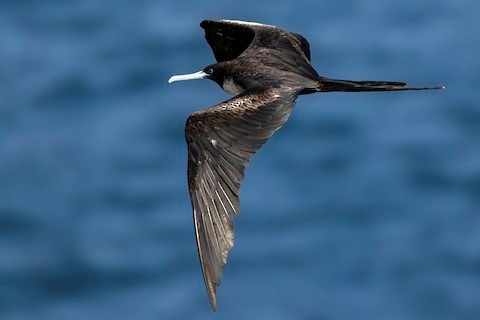
Magnificent Frigatebird, female, showing blond alar bar on upperwing. (Mirador El Faro, Oaxaca, Mexico; December 20, 2018.) © Bradley Hacker

Magnificent Frigatebird, female on nest with downy chick. (North Seymour Island, Galápagos, Ecuador; November 29, 2007.) © Raymond Marsh
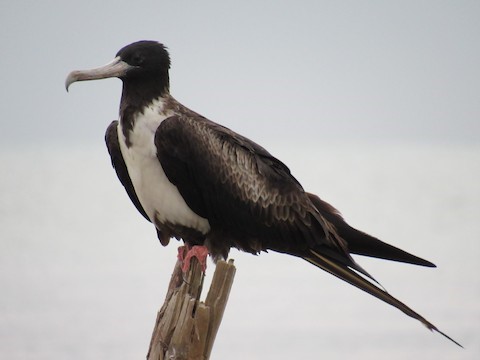
Magnificent Frigatebird, female, showing distinctive white vest, blackish hood, and blond alar bar on upperwing. (Dangriga, Stann Creek, Belize; February 3, 2020.) © Reymundo Chen

Magnificent Frigatebird, female, showing distinctive white vest, blackish hood, and blond alar bar on upperwing. (Codrington Lagoon Bird Sanctuary, Barbuda; January 21, 2019.) © Hannes Leonard
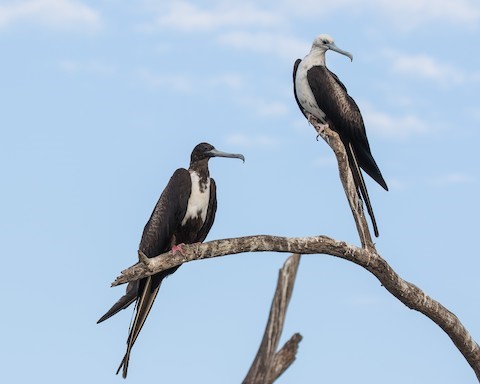
Magnificent Frigatebird, female and immature. (Ensenada Lodge, Puntarenas, Costa Rica; April 3, 2017.) © J.B. Churchill

Magnificent Frigatebird, female, panting and expanding its flexible throat pouch. (North Seymour Island, Galápagos, Ecuador; June 15, 2017.) © Santiago Tabares
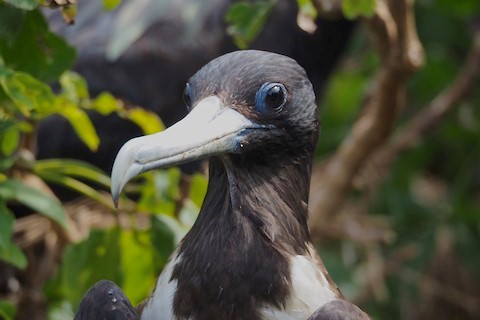
Magnificent Frigatebird, female, close-up showing massive hook-tipped bill and blue eyering. (Isla Isabel National Park, Nayarit, Mexico; February 8, 2018.) © Rob Worona
Juveniles and Older Immatures. Juvenile is brown overall with mostly white head, neck, and underparts. Like the adult female, it has a whitish alar bar on the upperwings.
Initially has a dark breastband—sometimes partial, sometimes complete—which disappears during the first year. The darkest juveniles, with complete breastbands, show a diamond-shaped white belly-patch.
First-cycle immatures have almost entirely white heads and underparts.
Second-cycle birds develop some darker patches mainly around the head and belly. Afterward the sexes begin to differentiate more noticeably.

Magnificent Frigatebird, juvenile, showing complete breastband and diamond-shaped white belly-patch. (Mayagüez, Puerto Rico; January 18, 2018.) © Luis Muñoz
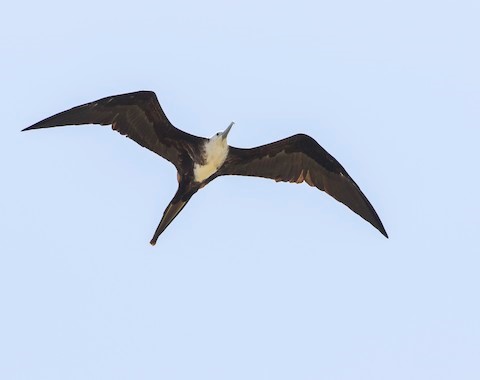
Magnificent Frigatebird, juvenile, showing typical white head and underparts and dark partial breastband. (Playa Tarcoles, Puntarenas, Costa Rica; March 29, 2019.) © Caleb Putnam
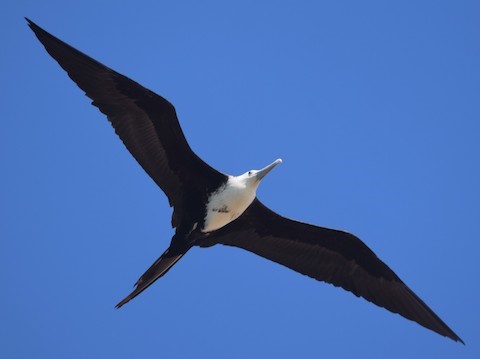
Magnificent Frigatebird, older immature, lacking partial breastband. (Mayagüez, Puerto Rico; January 18, 2018.) © Luis Muñoz
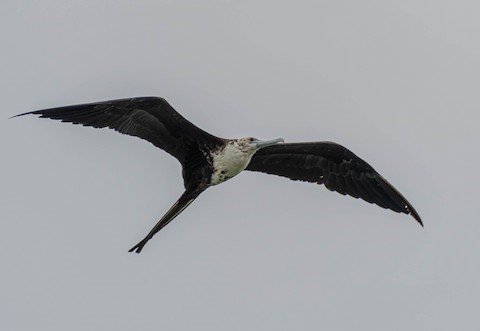
Magnificent Frigatebird, older immature, lacking partial breastband. (Bolivar-Galveston Ferry, Galveston, Texas; May 31, 2020.) © Chris Bick

Magnificent Frigatebird, juvenile. (Caye Caulker, Belize; January 28, 2020.) © Fidelio Montes Jr.
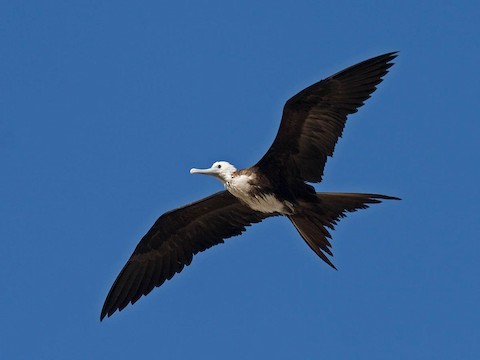
Magnificent Frigatebird, juvenile, showing white head and underparts and dark partial breastband. (Laguna del Mar, Sonora, Mexico; July 3, 2017.) © Greg Gillson
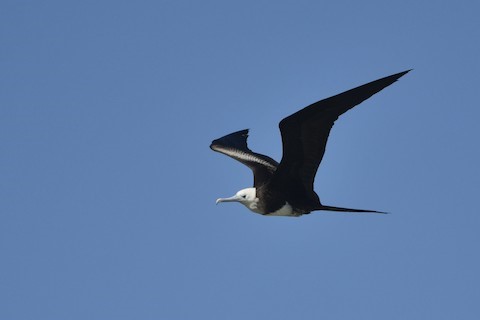
Magnificent Frigatebird, juvenile, showing white head, dark partial breastband, diamond-shaped white belly-patch, and whitish alar bar. (Dry Tortugas National Park; February 13, 2020.) © Jonathan Irons
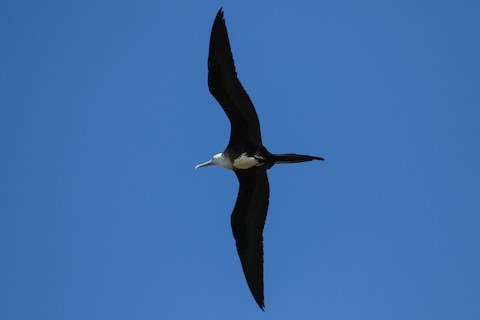
Magnificent Frigatebird, juvenile, showing white head and underparts and dark partial breastband. (Playa Hermosa, Guanacaste, Costa Rica; December 3, 2018.) © Blair Dudeck
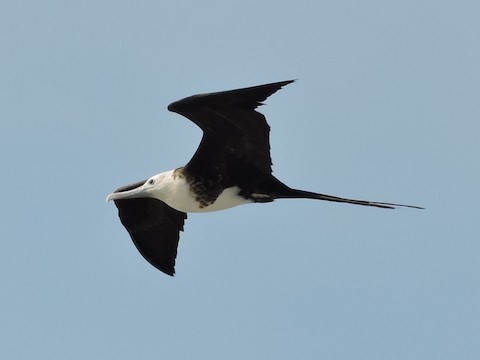
Magnificent Frigatebird, juvenile, showing white head and underparts and dark partial breastband. (Dunedin, Florida; January 3, 2017.) © Bob Lane
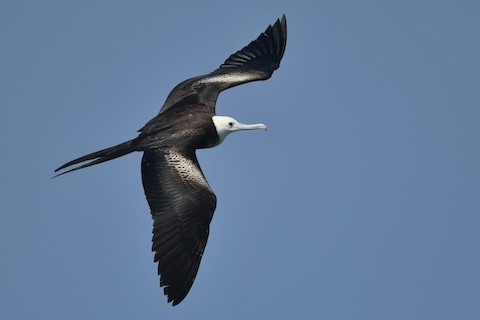
Magnificent Frigatebird, immature, showing white head and alar bars. (Dry Tortugas National Park; February 13, 2020.) © Jonathan Irons
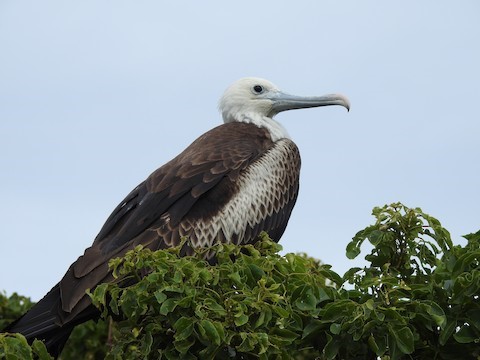
Magnificent Frigatebird, immature, showing white head and alar bar. (Isla Isabel National Park, Nayarit, Mexico; December 13, 2017.) © Edward Jordan
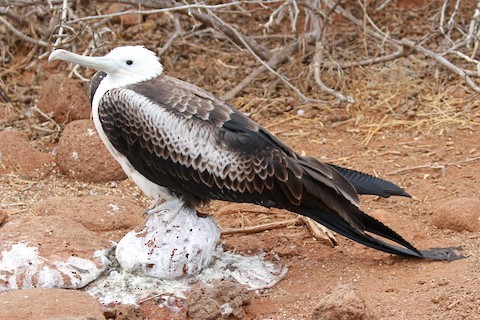
Magnificent Frigatebird, immature, showing white head, underparts, and alar bar. (North Seymour Island, Galápagos, Ecuador; November 12, 2017.) © Jordan Roderick
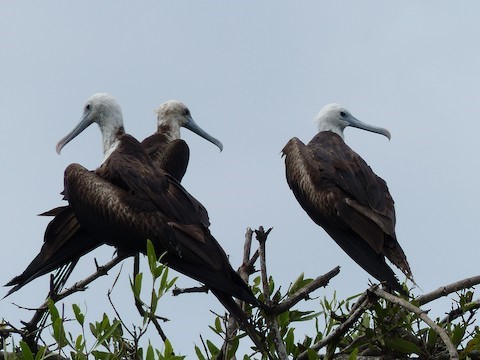
Magnificent Frigatebird, immatures—the one showing darker markings on the head is likely older. (Padre Ramos Nature Reserve, Chinandega, Nicargua; June 20, 2017.) © Ariel Salinas
Subadult Female. Subadult females go through various intermediate stages in which the white on the head and belly fills in with darker feathers.

Magnificent Frigatebird, subadult female. (Leamington, Ontario; July 1, 2017.) © Darlene Friedman
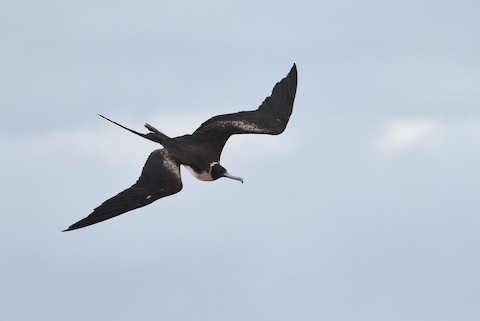
Magnificent Frigatebird, subadult female, showing remnant pale collar. (Punta Algarrobo, Mayagüez, Puerto Rico; May 22, 2017.) © Alex Lamoreaux
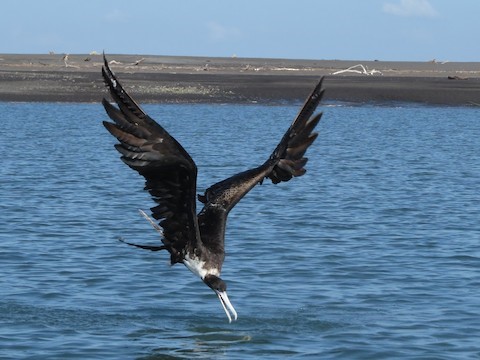
Magnificent Frigatebird, subadult female, showing remnant pale collar. (Islas Los Farallones, Chinandega, Nicargua; September 12, 2015.) © Jessie Stuebner
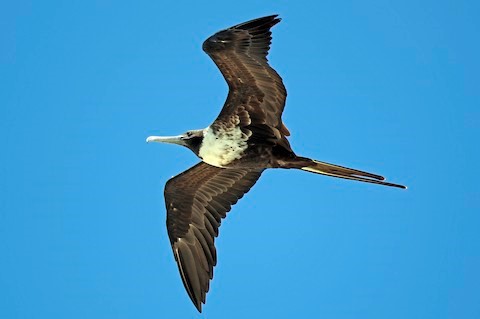
Magnificent Frigatebird, subadult female. (Garden Key, Dry Tortugas National Park, Florida; June 13, 2020.) © Tammy McQuade

Magnificent Frigatebird, subadult female, showing remnant pale collar. (Bubali Bird Sanctuary, Aruba; July 7, 2019.) © Michiel Oversteegen

Magnificent Frigatebird, subadult female, showing remnant pale collar. (Isla Santa Cruz, Galápagos, Ecuador; September 5, 2014.) © Darren Clark
Subadult Male. Subadult males also go through various intermediate stages, but differ from females in that they fill in patchily throughout the head and underparts. The belly is often the last area to darken.

Magnificent Frigatebird, subadult male. (Bubali Bird Sanctuary, Aruba; June 2, 2020.) © Michiel Oversteegen
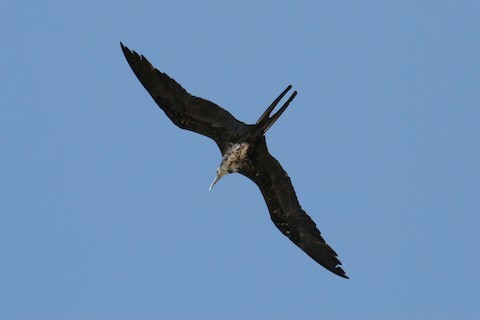
Magnificent Frigatebird, subadult male in the early stages of darkening. (Quintana Beach, Texas; July 5, 2010.) © Janet Rathjen
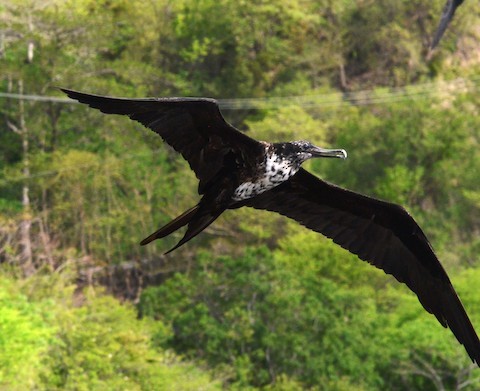
Magnificent Frigatebird, subadult male in the early stages of darkening. (St. Joseph, Dominica; May 1, 2013.) © Gerhard Tauscher

Magnificent Frigatebird, subadult males, with some residual pale feathers on their bellies. (Puntarenas, Costa Rica; March 26, 2018.) © J. Fine
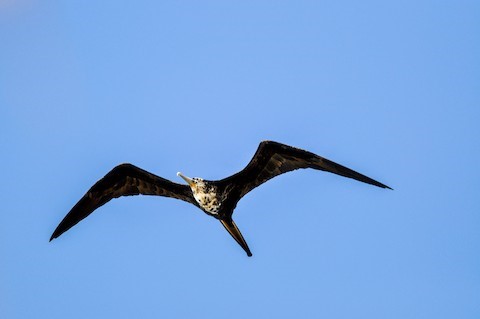
Magnificent Frigatebird, subadult male. (Cotton Tree Bay, Cayman Brac, Cayman Islands; December 25, 2014.) © Christine Kozlosky
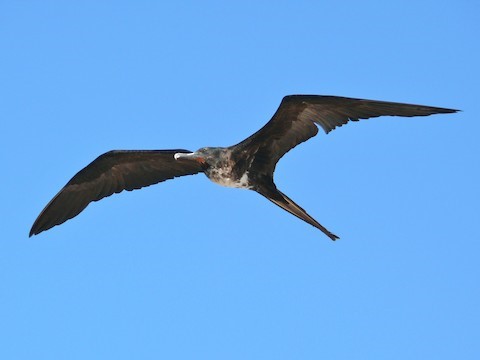
Magnificent Frigatebird, subadult male in the early stages of darkening. (North Seymour Island, Galápagos, Ecuador; November 29, 2007.) © Raymond Marsh
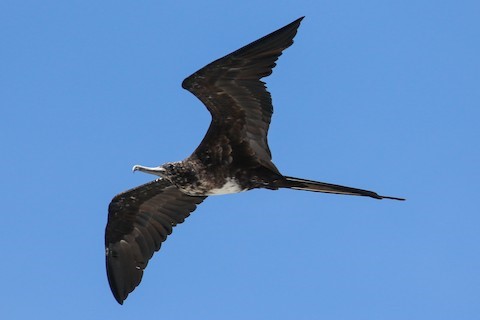
Magnificent Frigatebird, subadult male with white mainly on the belly. (Playa Hermosa, Guanacaste, Costa Rica; December 3, 2018.) © Blair Dudeck
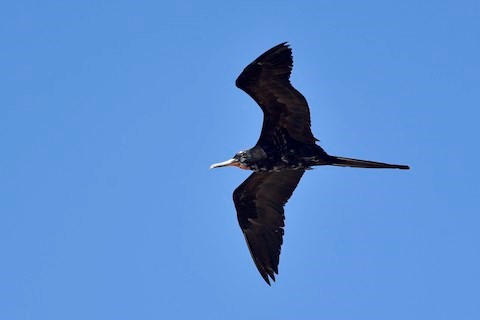
Magnificent Frigatebird, subadult male, nearly in full adult plumage with a few pale feathers remaining. (Dry Tortugas National Park; February 13, 2020.) © Daniel Irons
Cf. Great Frigatebird. Magnificent and Great Frigatebirds occur together regularly in the Galápagos and Ecuadorian waters, around remote Mexican islands, and to a very limited extent in Brazilian waters. They likely occur together somewhat more often in the eastern Pacific, but would be difficult to recognize due to their confusing similarities and the difficulty of tracking the various distinctions that apply to certain plumages.
Adult Males: Effectively indistinguishable under most field conditions. If the upperparts are visible, the presence of a distinct alar bar on the wings would suggest Great. If the lighting is right to catch reflections, Great often shows a strong green or purple gloss on the back feathers, whereas Magnificent is usually duller and purplish or coppery.
Adult Females: Distinctive. Magnificent has a full blackish hood, whereas Great has a pale throat. In the eastern Pacific populations, which are most likely to occur together, the females also differ in their eyerings: bluish on Magnificent, red on Great. Bill color differs accordingly, but to a lesser extent.
Immatures: Often distinctive, but complex and sometimes indistinguishable. Juveniles and older immatures are often distinguishable, as most juvenile Greats have a tawny (or buffy or orange or reddish) hood, which they retain at least in part into the second year. However, immature Greats are polymorphic and some portion of them have an all-white head like Magnificent—in which case, there may be no reliable field character. As they age, the differences become less pronounced, such that second-cycle immatures are mostly similar both within and between the two species.
Subadult Females: Sometimes distinguishable, but complicated. Female Magnificents begin to darken on the throat, whereas female Greats do not, so this may allow for positive identification of Magnificent in some cases. Female Greats often have pinkish bills, while female Magnificent’s bill is generally pale grayish or horn-colored.

Magnificent Frigatebird, subadult female, showing complete dark hood with pale collar. (Leamington, Ontario; July 1, 2017.) © Darlene Friedman

Great Frigatebird, subadult female. (Kilauea Point National Wildlife Refuge, Kauai, Hawaii; March 21, 2017.) © Laurens Halsey
Subadult Males: Distinctive, but complicated. The subadult male Magnificent is unique; it darkens in patches and becomes mottled throughout its underparts, usually remaining whitest on the belly. The subadult male Great darkens first on the head and belly, developing a blackish hood and white vest. The resulting pattern first resembles the adult female Great, then the adult female Magnificent, except that the shape of the white vest is different: somewhat U-shaped.
Cf. Lesser Frigatebird. Magnificent and Lesser Frigatebirds occur together regularly to a very limited extent in Brazilian waters, and irregularly in the eastern Pacific—as Lesser has a history of long-distance vagrancy, including at least four records from North America and many from Hawaii. As the largest and smallest frigatebird species, their sizes may differ enough to be noticeable, but this is often difficult to judge.
Adult Males: Distinctive. Male Magnificent is essentially all-black, and male Lesser is readily recognized by its white armpit markings (usually conspicuous, but somewhat variable and can be subtle on some individuals).
Adult and Subadult Females: Sometimes indistinguishable by plumage alone (compare photos below). Both Magnificent and Lesser have a full blackish hood and white vest—and both can show pronounced white projections into the armpits, although this varies more on female Magnificent. Two features can be helpful.

Magnificent Frigatebird, female, showing white markings projecting into the armpits—similar to female Lesser Frigatebird. (Cancún, Quintana Roo, Mexico; February 17, 2015.) © Alexandre Gualhanone

Lesser Frigatebird, subadult female. (Lady Elliot Island, Queensland, Australia; March 14, 2020.) © Barry Deacon
First, adult female Lesser has a complete and usually well-defined white collar, whereas adult female Magnificent has a dark nape. Subadult female Magnificent can show a full white collar, but usually not as well-defined as on Lesser.
Second, the typical shapes of the white and black areas on the underparts differ (although both species vary): on Magnificent, the black belly projects toward the chest in a V, whereas on Lesser, this boundary is typically more U-shaped.
Immatures: Distinctive, but complex. Juveniles and most older immatures are distinguishable in multiple ways. Juvenile Lesser varies widely but seems to always have some buffy, tawny, orange, or rusty coloration on the head or neck, whereas juvenile Magnificent has all-white head and neck.
Older immatures of both species differ more in the pattern of the chest and sides: immature Lessers typically have a complete or partial black collar at chest level, whereas immature Magnificent can have a partial breastband, but it is lower on the body.
Subadult Males: Distinctive. The subadult male Magnificent is unique; it darkens in patches and becomes mottled throughout its underparts, usually remaining whitest on the belly. The subadult male Lesser darkens first on the head and belly, also becoming mottled throughout its underparts, but remaining whitest on the chest and armpits.
Notes
Monotypic species, but the Galápagos population has been proposed for recognition as a separate subspecies.
References
Alderfer, J., and J.L. Dunn. 2014. National Geographic Complete Birds of North America (Second Edition). National Geographic Society, Washington, D.C.
Ascanio, D., G.A. Rodriguez, and R. Restall. 2017. Birds of Venezuela. Christopher Helm, London.
BirdLife International. 2018. Fregata magnificens. The IUCN Red List of Threatened Species 2018: e.T22697724A132597208. https://dx.doi.org/10.2305/IUCN.UK.2018-2.RLTS.T22697724A132597208.en. (Accessed August 8, 2020.)
eBird. 2020. eBird: An online database of bird distribution and abundance. Cornell Lab of Ornithology, Ithaca, N.Y. http://www.ebird.org. (Accessed August 8, 2020.)
ffrench, R. 2012. A Guide to the Birds of Trinidad & Tobago (Third Edition). Cornell University Press.
Garcia-del-Rey, E. 2011. Field Guide to the Birds of Macaronesia: Azores, Madeira, Canary Islands, Cape Verde. Lynx Editions, Barcelona.
Harrison, P. 1983. Seabirds: An Identification Guide. Houghton Mifflin, Boston.
Howell, S.N.G., and S. Webb. 1995. A Guide to the Birds of Mexico and Northern Central America. Oxford University Press.
Howell, S.N.G., and K. Zufelt. 2019. Oceanic Birds of the World. Princeton University Press.
Kirwan, G.M., A. Levesque, M. Oberle, and C.J. Sharpe. 2019. Birds of the West Indies. Lynx Edicions, Barcelona.
Lee, D.S. and W.A. Mackin. 2009. Magnificent Frigatebird. West Indian Breeding Seabird Atlas. http://www.wicbirds.net/mafr.html. (Posted April 8, 2009. Accessed August 8, 2020.)
McMullan, M., and T. Donegan. 2014, Field Guide to the Birds of Colombia (Second Edition). Fundación Proaves de Colombia, Bogotá.
Raffaele, H., J. Wiley, O. Garrido, A. Keith, and J. Raffaele. 1998. A Guide to the Birds of the West Indies. Princeton University Press.
Ridgely, R.S., and P.J. Greenfield. 2001. The Birds of Ecuador, Volume II: Field Guide. Cornell University Press.
Schulenberg, T.S., D.F. Stotz, D.F. Lane, J.P. O’Neill, and T.A. Parker. 2007. Birds of Peru. Princeton University Press.
van Perlo, B. 2009. A Field Guide to the Birds of Brazil. Oxford University Press.
Wells, J.V., and A.C. Wells. 2017. Birds of Aruba, Bonaire, and Curaçao. Cornell University Press.

